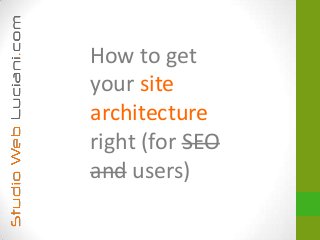
How to get your site architecture right (for SEO and users)
- 1. How to get your site architecture right (for SEO and users)
- 2. Information Architecture The main goal of effective information architecture is to make information, products and services easy to find from users and search engines on your website. Build the information architecture of your website first and foremost for users, keeping content laid in a logical way and accessible to accommodate search engines. SEO – SEM– Social
- 3. Complex? Simple? … Logical SEO – SEM– Social
- 4. Some guidelines • Search engine crawlers will tend to primarily crawl links that are at most 3 or 4 clicks away from your homepage, therefore you should strive to keep your most important content within those 3-4 tiers. • Build a navigation that reflects users behavior. Use analytics and study your internal site searches to learn more about what users are looking for most. • Use relevant, attractive and easy to understand “navigation labels” (anchor texts, menus, buttons). SEO – SEM– Social
- 5. (…) Some guidelines • Remember the “don’t make me think” rule. Strive to make your site navigation “obvious”. Your grandmother should be able to navigate your website… without thinking. • Research solutions, Plan and eventually test your Information Architecture. It’s almost impossible to get it right the first time. Remember to study your in-page analytics and be ready to take decisions. SEO – SEM– Social
- 6. Number of Links in a Page… How many links should you have on your pages? Google guidelines says: “Keep the links on a given page to a reasonable number.” Matt Cutts said: “At any rate, you’re dividing the PageRank of that page between hundreds of links, so each link is only going to pass along a minuscule amount of PageRank anyway. Users often dislike link-heavy pages too, so before you go overboard putting a ton of links on a page, ask yourself what the purpose of the page is and whether it works well for the user experience.” SEO – SEM– Social
- 7. … no magic rule SEO professionals usually tend to lay on a 100 link per page limit strategy to enhance the link juice to the most important pages, but I totally disagree with this common practice. Decide the numbers of links on a page to offer the best user experience possible. Some pages by their very nature will have and should have a lot of links (sometimes more than 100) , others will not. SEO – SEM– Social
- 8. SEO Human Friendly URLS Short + Descriptive + Memorable = Communicable Your content should be easily sharable and viral, for this reason URLs should be communicable to others. Ask yourself: Are my most important URL’s communicable without a digital mean? Are they easy to remember? SEO – SEM– Social
- 9. Keywords in URLs URL’s should also include the most relevant keywords in the directory structure for 2 purposes: 1) It’s another indicator to Search Engines to let them know what the page is about. 2) The keyword will be bolded in SERPs enhancing CTR. SEO – SEM– Social
- 10. Final Thoughts Design your website taxonomy and architecture to offer the best user experience possible. Search engines will love you for this too! But please note, designing for users doesn’t mean you should forget about SEO. Some technical guidelines should be followed (urls, anchor texts, number of links, canonicalization, link deepness). Just make sure you don’t forget your main target. SEO – SEM– Social
- 11. Simone Luciani in a nutshell I’m a Digital Marketing Consultant specialised in SEO & Search Marketing in English and Italian Markets. Based in London. I have a degree in Internet Marketing and a Master in Digital Marketing (The Institute of Direct and Digital Marketing – London). I’m a Google Qualified Individual certified for Adwords and Google Analytics. I have worked for 4 years as SEO Manager in eBay. I founded Studio Web Luciani in 2009, working for companies like HomeAway, Expedia, RAI, Amadori, Groupon, Fila, Piaggio, CESVI, REPLAY and more. I’m the Author of Rankfirst – SEM Blog, and an occasional collaborator of Search Marketing Standard (USA) and Search Engine People (Canada). I’m also a teacher for the Bewe Academy (Social Marketing Master).
- 12. Thank You! Contacts: Mobile: +44 (0)79 00 46 26 12 Landline: +44 (0)20 81 80 21 03 Email: simone@studiowebluciani.com Web: http://www.studiowebluciani.co.uk Linkedin: www.linkedin.com/in/studiowebluciani SEO – SEM– Social
